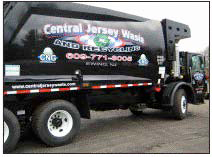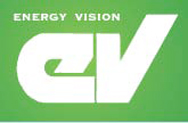A Greener Future For The Garden State? The Role of Natural Gas Vehicles (continued)
And while the State’s new Global Warming Response Act recognizes the primary role that transportation plays in generating greenhouse gases (38%), it focuses mainly on automobiles, where electric vehicle and smart grid systems – important areas of innovation – will take years to work out. The Act gives very little emphasis to heavy–duty fleets, where by far the greatest assured near term gains can be made[xxviii].

One of the new CJW trucks serving Hamilton, NJ
The new Administration, however, has made the use of natural gas in fleets, for the first time, a significant priority. A leadership voice can mean a great deal in promoting change. New Jersey can now both take maximum advantage of the federal tax incentive programs aimed at encouraging municipalities and fleets to shift from diesel to natural gas fuel. These incentives cover 80% of the higher costs of buying natural gas models and also cover up to 50% of the cost of installing refueling stations for alternative fuels, including natural gas[xxix]. But it can do more.
New Jersey’s Senator Robert Menendez has taken a leadership role in sponsoring new federal legislation, the "NAT GAS" act, extending and expanding these incentives. Senator Frank Lautenberg is behind it as well. The House version of the bill is co–sponsored by 5 of 13 New Jersey representatives[xxx].
Municipal leaders may, however, play the leading role. When their waste contracts come up for renewal, they can simply make the use of the cleanest fuel available a criterion for bidders as some communities are doing. Some solid waste companies, to better serve their customers and protect the health of their communities may make this shift voluntarily.
But every New Jerseyan can have an important voice. You may want to encourage maximum support by your legislators of NAT GAS. You can encourage state establishment of a grant program covering the 20% of higher costs for CNG trucks not covered by the national program, creating a true "level playing field" for this technology. You can distribute this fact sheet to your friends and colleagues and advocate for change in your community.

Proud sons of CJW Vice President Michael Fiumefreddo at the launching of its new CNG fleet
For municipalities and citizens to learn more about the environmental, health and economic benefits of a shift to natural gas fleets and how to explore a local initiative, sources of information include:
New Jersey Clean Cities Coalition
1 Bank Street, Suite 202, PO Box 223, Rockaway, NJ 07866
(973) 886–1655
Attn: Chuck Feinberg chuck.feinberg@gmail.com
Energy Vision
138th East 13th Street, New York, NY 10003
(212) 228–0225
Attn: Joanna Underwood underwood@energy–vision.org
New Jersey Department of Environmental Protection
P. O. Box 402, Trenton, NJ 08625–0402
(609) 292–1122
Attn: Melinda Dower Melinda.dower@dep.state.nj.us
American Lung Association in New Jersey
1031 Route 22 West Suite 203, Bridgewater, NJ 08807
(908) 685–8040
Attn: Marianne Dalessio mdalessio@lunginfo.org
Natural Gas Vehicles for America
400 N. Capitol St. NW, Washington, DC 20001
(202) 824–7366
Attn: Richard Kolodziej Kolodziej@ngvamerica.org
This fact sheet was prepared by Energy Vision, a New York based national non–profit energy organization, in collaboration with the New Jersey Clean Cities Coalition. Research was conducted by EV intern Neal Day from Drew University.

